You'll Learn
- Why Mattress Protectors Matter in Hospitality
- What Is a Best Hotel Mattress Protector?
- Why Hotel Mattress Protectors Are Essential?
- Types of Mattress Protectors for Hotels
- How to Choose the Right Hotel Mattress Protector
- Care and Maintenance for Long-Lasting Mattress Protection
- FAQs: Hotel Mattress Protector
- Protect Your Bedding, Delight Your Guests
Why Mattress Protectors Matter in Hospitality
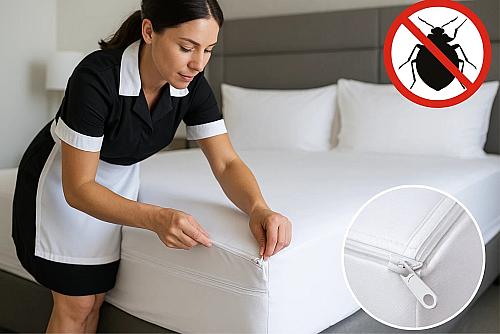
When managing a hotel, ensuring guest comfort and maintaining mattress longevity are top priorities. A hotel mattress protector is a critical investment that enhances bedding hygiene, protects costly mattresses, and elevates the guest experience.
Whether you're a hotelier upgrading your bedding or a procurement manager seeking durable solutions, this guide will walk you through everything you need to know about choosing the right mattress protector for your property. From waterproof options to eco-friendly materials, we’ll cover benefits, features, and key considerations to help you make an informed decision.
What Is a Best Hotel Mattress Protector?

A hotel mattress protector is a fitted or zippered fabric covering placed over the mattress to protect it from moisture, stains, bacteria, dust mites, and other forms of contamination.
Unlike mattress pads (which provide cushioning) or toppers (which alter firmness), protectors focus on preserving hygiene and extending mattress lifespan. In the hospitality industry, they are often considered a non-negotiable item for guestroom cleanliness.
Mattress Protector vs Mattress Pad vs Mattress Cover: Key Differences
When it comes to mattress protection and comfort, the terms "mattress protector," "mattress pad," and "mattress cover" are often used interchangeably, but they serve different purposes.
| Feature | Mattress Protector | Mattress Pad | Mattress Cover (Mattress Encasement) |
|---|---|---|---|
| Main Function | Protection | Comfort + Light Protection | Full Protection |
| Waterproof | Often | Sometimes | Sometimes |
| Allergen/Bed Bug Barrier | Yes (some) | No | Yes |
| Comfort Added | Minimal | High | None |
| Enclosure Type | Top + sides | Top only | Full (top, sides, bottom) |
| Washable | Yes | Yes | Yes |
A mattress protector is designed primarily for hygiene and defence. It acts as a barrier between the mattress and external elements such as spills, sweat, allergens, dust mites, and even bedbugs. Most are thin, waterproof, and breathable, making them ideal for hospitality settings where cleanliness is critical.
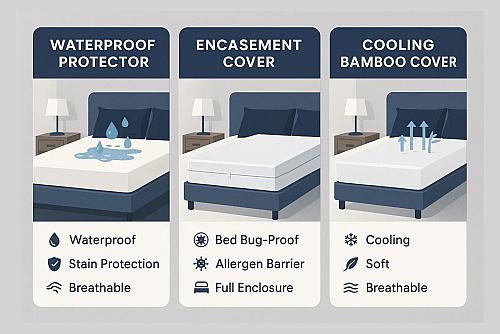
In contrast, a mattress pad focuses more on comfort. It adds a cushioned layer to soften a firm mattress or provide additional support. While some mattress pads offer minimal waterproofing, their main function is to enhance sleep quality rather than protect the mattress.
On the other hand, a mattress cover—often referred to as a mattress encasement—offers full enclosure protection. It completely wraps around the mattress, typically with a zippered closure, safeguarding it from bedbugs, allergens, and moisture. Mattress covers are commonly used in healthcare facilities or for long-term mattress storage due to their 360-degree protection
In practice, many choose to layer these products—using an encasement for full protection, a protector for everyday hygiene, and a pad for added comfort. Understanding the difference between these three can help you make informed decisions, whether you're upgrading hotel bedding, furnishing a guest room, or extending the life of a new sleep setup.
Why Hotel Mattress Protectors Are Essential?
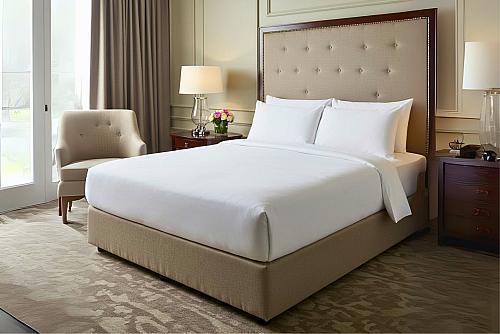
Imagine a guest checking into your hotel, excited for a restful stay, only to find a stained or uncomfortable mattress. That single experience could lead to negative reviews and lost business. A hotel mattress protector acts as a shield, preserving mattress durability and ensuring bedding cleanliness. According to a Hotelier magazine, guests prioritize hygiene when choosing accommodations, making mattress protection for hotels a non-negotiable.
These protectors safeguard against spills, allergens, and wear, extending bedding lifespan by up to 30%, per industry estimates. They also enhance guest comfort by providing a clean, breathable sleep surface, addressing key concerns for travellers. By investing in a commercial mattress protector, you’re not just protecting your assets—you’re building trust with guests.
Key Functions:
- Acts as a barrier against liquids, bodily fluids, and spills
- Prevents dust mites, bacteria, and allergens from settling into the bedding
- Deters bed bugs and pests (especially full encasement styles)
- Reduces wear and tear, extending the mattress’s useful life
In a hotel setting, where turnover is high and the risk of accidents is constant, a guest bed protector is your first line of defence. And when cared for properly, it can help your hotel maintain exceptional cleanliness standards without frequent mattress replacements.
Key Benefits of Using a Hotel Mattress Protector
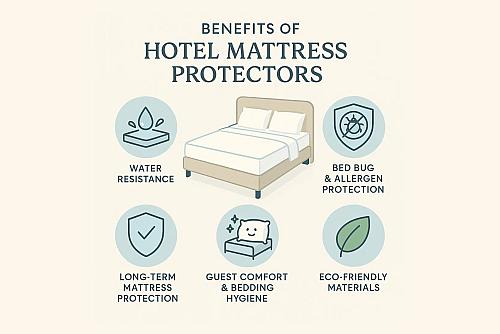
A high-quality hotel mattress protector offers multiple advantages for hoteliers and guests alike. Here’s why they’re a must-have:
- Mattress Lifespan Extension: Protectors shield mattresses from spills, stains, and physical wear, reducing replacement costs. A 2024 hospitality report noted that hotels replacing mattresses every 5–7 years could extend this to 8–10 years with proper protection.
- Enhanced Guest Experience: A clean, comfortable bed improves sleep quality, leading to higher guest satisfaction and repeat bookings.
- Bed Hygiene and Allergen Control: Protectors block dust mites, bacteria, and allergens, critical for guests with sensitivities. This is especially important as 1 in 5 travelers report allergies, per a 2023 travel survey.
- Cost Savings: By preventing damage, protectors reduce the need for frequent replacements and costly deep-cleaning services.
- Sustainability: Eco-friendly options, like bamboo mattress protectors, align with growing consumer demand for sustainable bedding, with 65% of travelers preferring eco-conscious hotels, according to Booking.com.
Want a quick explainer on their importance? Read our blog: Top Reasons to Use a Mattress Protector in Hotels.
Types of Mattress Protectors for Hotels
Not all mattress protectors are created equal. The hospitality sector demands materials and features designed to withstand industrial laundering, repeated use, and varied guest needs.
There’s no one-size-fits-all when it comes to a protective bedding layer in hospitality. The best choice depends on your guest profile, location, climate, and brand positioning.
Type Waterproof Breathable Best For Cost Noise
| Type | Waterproof | Breathable | Best For | Cost | Noise |
|---|---|---|---|---|---|
| Vinyl | ✅ | ❌ | Budget Hotels | Low | High |
| TPU-backed | ✅ | ✅ | Mid-range | Medium | Low |
| Bamboo | ✅ | ✅ | Luxury & Eco-Friendly | High | Low |
| Encasement | ✅ | ✅ | Allergy Protection | Medium | Low |
Here’s a breakdown of the most common types found in hotels and what makes them suitable for specific needs:
1. Waterproof Mattress Protectors for Hotels
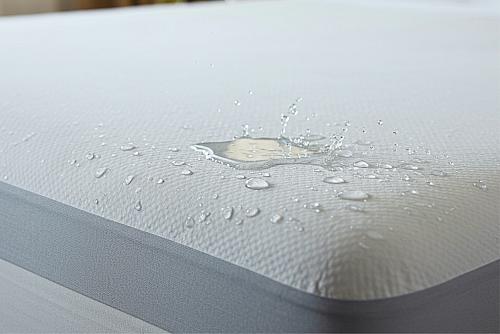
Why Waterproofing Matters? Spills are inevitable in hotels—whether it’s a guest’s coffee or a child’s accident. A waterproof mattress protector creates a reliable barrier against liquids, preventing damage to the mattress core. These protectors often use advanced materials like polyurethane or vinyl-backed fabrics, which are both waterproof and breathable.
For example, a mid-range hotel chain reported a 40% reduction in mattress replacements after switching to waterproof mattress protectors. Look for options with breathable fabrics to ensure guest comfort, as non-breathable materials can trap heat and cause discomfort. A cotton terry mattress protector is a popular choice, combining absorbency with a soft, hotel-quality feel.
Recommended Features:
- TPU backing (quiet and breathable)
- Machine washable at high temperatures
- Soft upper layer (cotton or terry) for guest comfort
- Elastic edges or a fitted skirt for a secure fit
Vinyl-backed covers are fully waterproof but can be noisy and less breathable. Use them for budget properties or situations where maximum protection outweighs guest comfort.
2. Allergen-Proof and Bed Bug Mattress Encasements
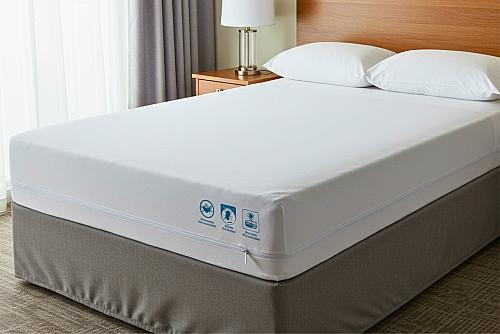
Bed bugs are a hotelier’s nightmare, with a single infestation costing thousands in remediation and lost revenue. A mattress encasement or bed bug protector fully encases the sleep surface, sealing it off from pests. These zippered protectors are designed with micro-weave fabrics that prevent bedbugs and dust mites from penetrating.
A full mattress encasement surrounds the entire sleep surface, zipping closed to provide complete protection against allergens, dust mites, and bedbugs. These are often used in urban hotels or facilities that want to be proactive about pest management.
Use Cases:
- Hotels in densely populated areas
- Allergy-sensitive guests
- Properties near woodlands or infested zones
Essential Features:
- Micron pore size below 5 microns
- Secure zipper closures with sealed seams
- Breathable and moisture-wicking fabric
- Anti-bacterial treatment or certifications
A bedbug outbreak can cost hotels thousands in pest control, revenue loss, and reputation repair. Encased protectors serve as a smart preventive strategy.
A 2022 hospitality study found that hotels using bed bug encasements reduced pest-related complaints by 85%. Opt for a dust mite-proof protector to address allergens as well, ensuring a hygienic sleep environment. When choosing, ensure the encasement is certified for bed bug protection and fits snugly to avoid wrinkles that could affect guest comfort.
3. Breathable and Cooling Mattress Covers

Hotels in warmer regions—or luxury properties—often invest in cooling and breathable mattress protectors. These allow airflow and temperature regulation while still offering protection.
Best Materials:
- Bamboo fiber – Naturally breathable, moisture-wicking, antimicrobial
- Tencel – Smooth, eco-friendly, gentle on skin
- Cotton terry – Classic choice for comfort and absorbency
These protectors don’t feel plasticky or stiff. Instead, they enhance the sleep experience while discreetly protecting the mattress.
4. Eco-Friendly Mattress Protectors
For hotels prioritizing sustainability, eco-friendly mattress protectors made from OEKO-TEX certified mattress covers ensure no harmful chemicals are used, aligning with global safety standards. These materials not only enhance guest comfort but also support a hotel’s green initiatives, a factor 70% of travellers consider, per a 2024 Expedia report.
How to Choose the Right Hotel Mattress Protector
With so many options, how do you know which protector is right for your property? It comes down to balancing the protection level, the guest experience, and operational efficiency. Here are key factors to consider:
- Material Quality: Choose breathable, durable materials like bamboo, Tencel, or cotton terry. OEKO-TEX certified mattress covers guarantee safety and sustainability.
- Fit and Design: Opt for zippered protectors or fitted covers that stay secure during frequent bed changes. Ensure compatibility with your hotel bed sizes (e.g., king, queen).
- Protection Level: Decide between waterproof protectors for spill-heavy environments or encasements for bed bug and allergen protection.
- Ease of Care: Select protectors that withstand commercial laundry processes, as hotels require frequent washing without compromising quality.
- Sustainability: Eco-friendly mattress protectors like bamboo or Tencel appeal to environmentally conscious guests and reduce your hotel’s carbon footprint.
What Should Hotels Look for in a Mattress Protector?
Focus on durability, guest comfort, and ease of maintenance. A commercial mattress protector should withstand high wash cycles (200+ per year) and maintain its protective qualities. Check for certifications like OEKO-TEX and ensure the protector aligns with your brand’s commitment to sustainable bedding.
Care and Maintenance for Long-Lasting Mattress Protection
A mattress protector is only effective if it’s clean, intact, and properly fitted. Proper care extends the life of your hotel bedding protector and ensures consistent hotel bedding hygiene. Here’s how to care for protectors across daily hotel operations.
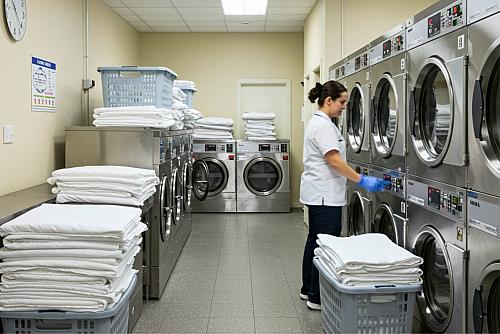
1. Regular Washing: Wash protectors weekly or after each guest checkout using commercial-grade detergents. Most waterproof mattress protectors and cotton terry mattress protectors are machine-washable, but check care labels to avoid damage.
Washing Frequency:
- Luxury or premium hotels: After every guest turnover
- Mid-scale hotels: Every 2–3 days or per checkout
- Long-stay or budget: Weekly or as needed
Always follow manufacturer guidelines and avoid detergents that degrade the waterproof barrier.
Commercial Laundry Tips:
- Wash in warm water (40–60°C) unless hot water is required
- Avoid bleach unless explicitly stated as bleach-safe
- Do not over-dry—this breaks down waterproof layers
- Skip fabric softeners, which reduce absorbency and breathability
2. Inspect for Wear: Check for tears or worn zippers quarterly, especially for mattress encasements. Replace damaged protectors to maintain bed hygiene.When to Replace a Protective Layer? Here are signs you need a new one:
- Fraying edges or torn seams
- Waterproof backing is cracked or peeling
- Shrinkage or poor fit
- Persistent odors or staining
On average, high-quality hotel mattress protectors last 12–18 months, depending on use frequency and laundering methods.
3. Stain Removal: Treat stains promptly with mild, non-bleach cleaners to preserve the protector’s appearance and functionality.
4. Storage: Store spare protectors in a dry, cool environment to prevent mold or mildew, especially for bamboo mattress protectors or Tencel mattress protectors.
A well-maintained protector not only protects your investment but also reinforces your commitment to bedding cleanliness, boosting guest trust.
FAQs: Hotel Mattress Protector
Q1. Are waterproof mattress protectors uncomfortable for guests?
Not at all! Modern waterproof mattress protectors use breathable fabrics like cotton terry mattress protectors or Tencel mattress protectors, which prevent liquid penetration while maintaining a cool, comfortable sleep surface.
Q2. What’s the best type of protector for a luxury hotel?
Breathable, waterproof protectors with soft-touch fabrics like bamboo or Tencel are preferred. Look for silent, rustle-free TPU layers and strong stitching.
Q3. Can a mattress protector prevent bed bugs?
Yes, zippered encasement protectors fully enclose the mattress, sealing out bed bugs. Look for micro-weave fabric and secure zippers for maximum protection.
Q4. How long do hotel mattress protectors last?
With proper care, a commercial-grade protector lasts 12–18 months under regular laundering. Rotate and inspect them frequently to maintain performance.
Q5. What should I avoid in a hotel mattress protector?
Avoid :
- Low-quality vinyl (noisy, uncomfortable)
- Protectors without certifications
- Products that shrink in high-heat drying
- Loose-fitting covers that shift during sleep
Protect Your Bedding, Delight Your Guests
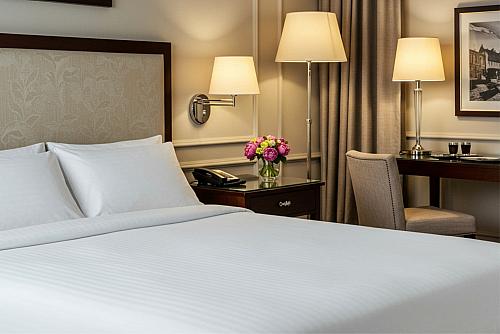
In hospitality, it’s often the invisible elements that make the biggest difference. A high-quality hotel mattress protector is one such example, working quietly behind the scenes to maintain cleanliness, reduce costs, and ensure guest satisfaction. Investing in a hotel bedding protector is a strategic move for any hotelier aiming to enhance guest comfort, extend the hotel bed's lifespan, and maintain impeccable bed hygiene.
Whether you choose a waterproof mattress protector, a zippered bed bug encasement, or a cooling bamboo cover, ensure it’s tailored to your property’s needs. With smart purchasing and proper care, a good protector can extend sleep surface life by 30–50%, saving thousands in replacement costs over time.
So, don’t leave your most expensive assets unprotected.Start exploring hotel-grade protectors that match your brand promise and operational goals.
Ready to Take the Next Step?
- Browse our range of commercial mattress protectors for hotels
- Request a custom quote for bulk mattress encasements
- Explore our full hotel bedding collection
- Speak with a hospitality specialist for tailored recommendations

